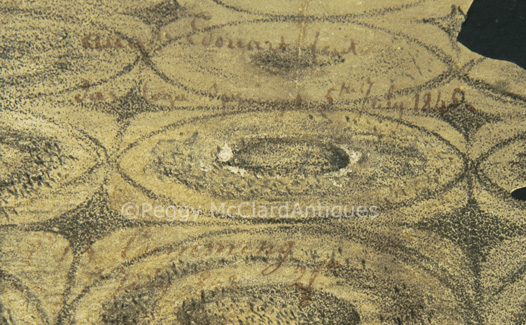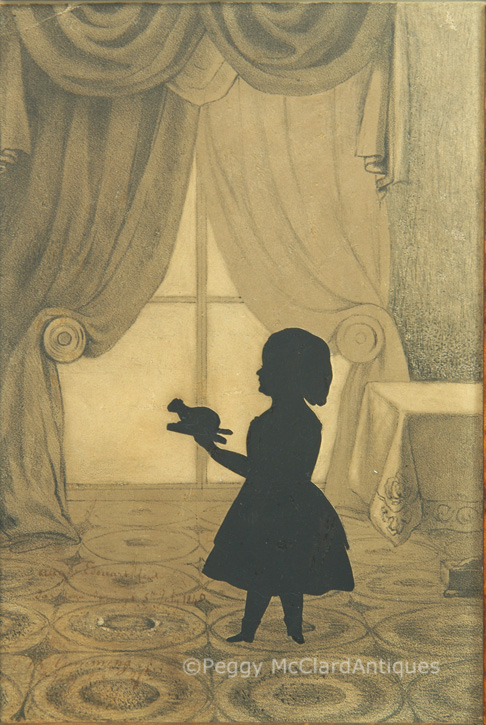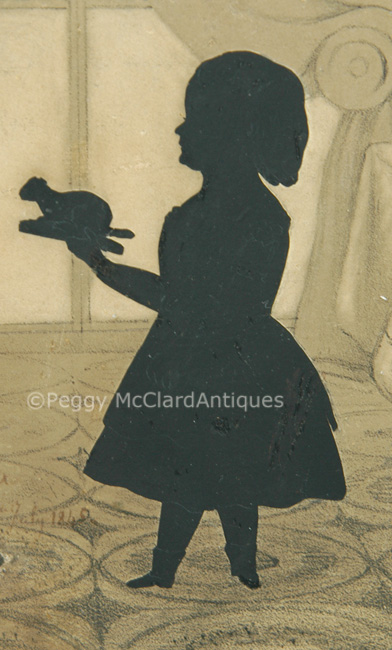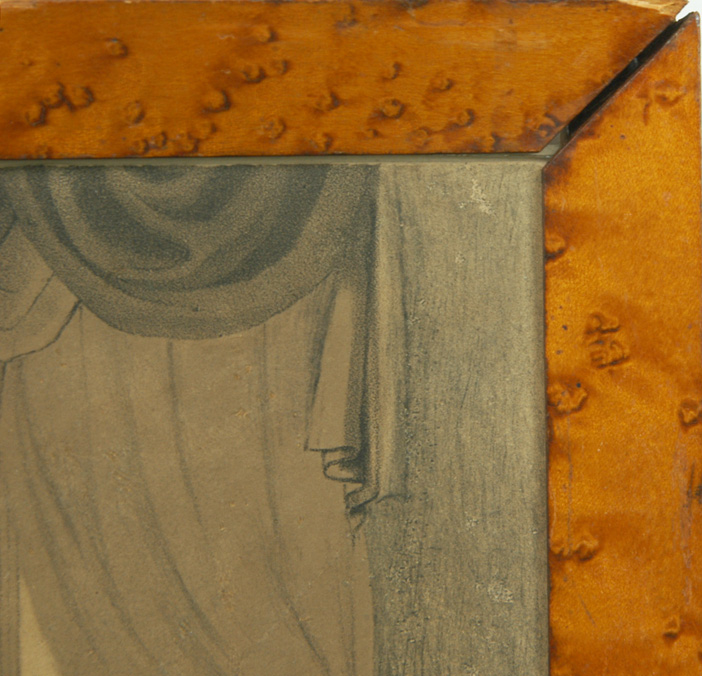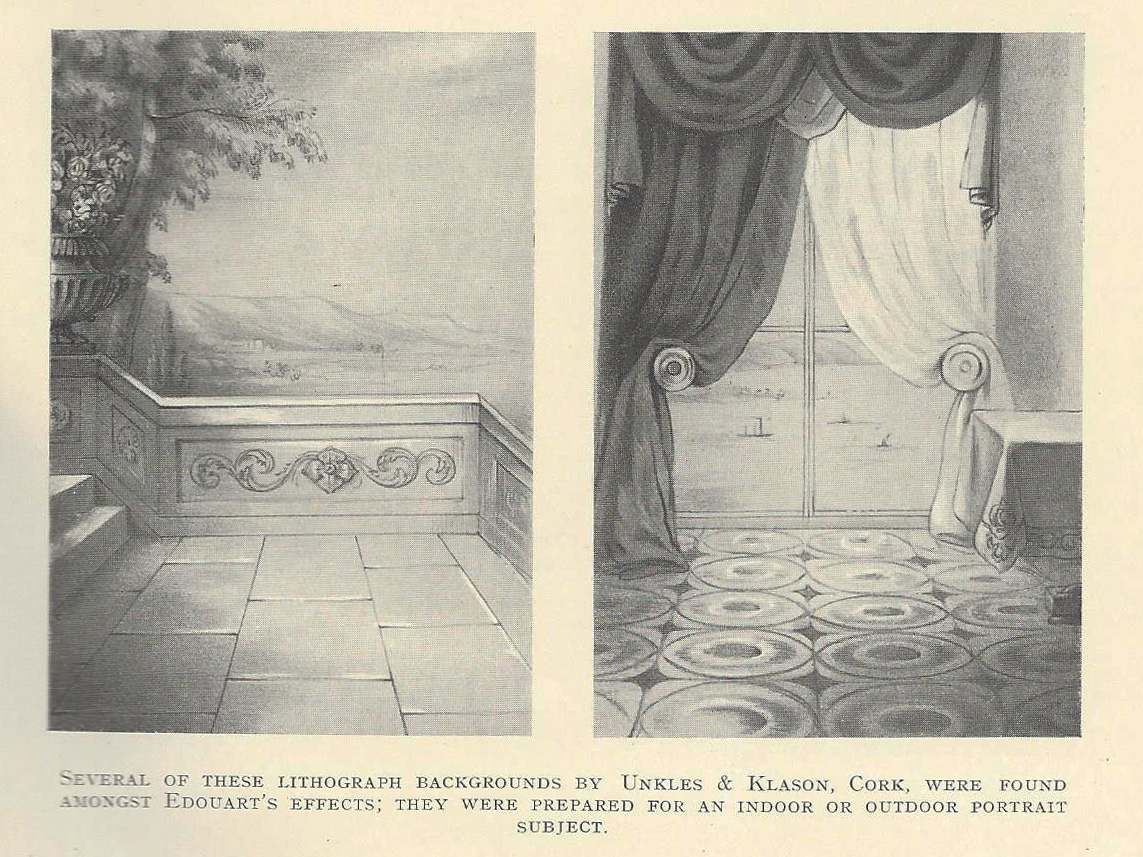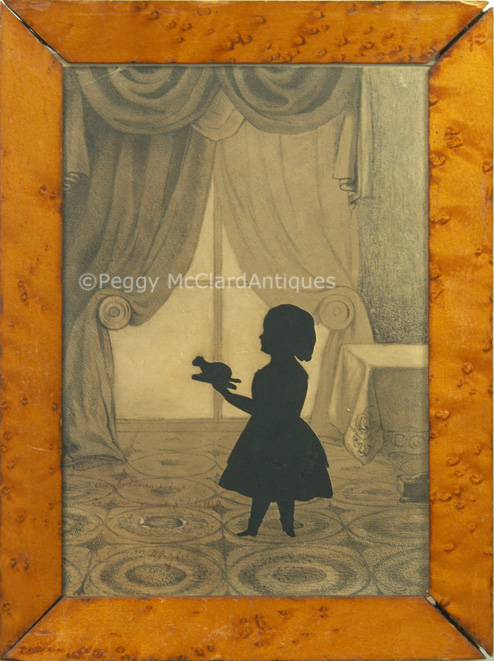
This is an unusual American-cut silhouette by the great master silhouettist Augustin Edouart. The silhouette is unusual on at least two points. First, the toy in the child’s hand is one I’ve not seen in Edouart’s work before. We know that he repeated many of the same props throughout his career, concerning himself much more in making a good likeness of the sitter while showing life and action instead of whether the props and interiors were personal to the sitter. This toy must have been important to the sitter and/or his parents who probably paid Edouart a bit extra to have it depicted. The toy appears to be a pipsqueak (generally a papier mâché animal above leather bellows which were squeezed to make a squeaking sound) and it looks to me like it might be a beaver. I have collected pipsqueaks for some years and, granted I have a very small collection, I’ve never seen a beaver! The second unusual detail is the frontal pose of the child. Edouart did few of these frontal poses (with the body facing the viewer and only the head turned in profile). Of those few silhouettes with frontal poses, the great majority of them were adults. Surely, the parents of this child chose this pose from Edouart’s many folios of duplicates which he used for marketing and from which sitters could pick poses, props, and the like.
The lower left of this lithograph background is signed and inscribed “Augn. Edouart fecit / Saratoga Springs 5th July 1845 / E. B. Cumming / Born 4th July 1843 2yrs”. The iron gall ink inscription is faded and I’ve given you a greatly enhanced photo below—the enhancement was necessary for me to read most of the script. Initially, I had a very difficult time finding anything on E.B. via genealogy research. I was assuming this was a silhouette of a girl, even though I know that both genders were dressed alike at that age, both genders wore long hair (often ringlets which this hair might be), and boys were more likely to be depicted with animals and animal-like toys (although that is not a certainty, either). But, after scratching my head and thinking about it a bit more, I decided that E.B. Cumming just might be a boy. Would parents identify their two-year old daughter by her initials? (Actually, I have a hard time thinking of parents identifying their 2 year old son by initials—but I had an uncle who was named with only initials, “TB” so you never know!) But I started looking for E.B. as a male. I found what might be this E.B. as E.B. Cumming who was listed in the 1900 US Census as born in 1845, a lawyer, living in Sanford, New York, married to Elizabeth G. Cumming. Now, the birth year is two years later than the year given by Edouart, but I couldn’t find a birth certificate and every document that I find for this E.B. has a different birth year—so I think this could be the child in the silhouette.
So, let’s assume for a moment that Lawyer E.B. is the same person as this silhouette. Further research shows this to be Ebenezer Cumming—who the 1920 census lists as Ebenezer D. Cumming, still married to Elizabeth and still listing himself as a lawyer. For some reason, Ancestry.com shows that the 1920 census lists him as Ebenezer Danforth Cumming, but the actual document has middle initial “D” but no middle name. The 1920 census shows Cumming’s birth year as about 1856. We must remember that the census registered was recorded by a census taker who handwrote information given to him verbally. Who knows whether the actual person being counted was the one who relayed the information to the census taker who did the actual recording or whether it passed through several hands (or mouths) before being registered. I found five different census records which list Ebenezer’s birth year anywhere from 1844 to 1856. Those census records show Ebenezer’s wife, Elizabeth, anywhere from 9 years younger than Ebenezer to 2 years older. This may not be the person in the silhouette—but this is the closest that I can come and I feel pretty good making this connection.
Assuming, again, that this is Ebenezer Cumming, I found a family tree that says he was born in Hamden, New York on February 14, 1855 (birthday almost certainly taken by the family from the 1900 census) to John Cumming1 and S. Margaret Kittle Cole. He married Elizabeth Gould More, daughter of Hezekiah More and Mary Harriet Alverson and was born in 1853 in Walton, New York. Together they had a daughter, Lucy Elizabeth Cumming who was born on July 17, 1884 in Walton, New York. The dates don’t jibe, but remember that family genealogy researchers are using the same documents that I am finding online, plus family folk history and possibly going to record keeping facilities to look at actual documents. But they have the same problems with mistaken recording. Of course, all of my research will be provided to the buyer.
Whew, now back to this wonderful silhouette. The lithograph is very close to one that Mrs. Jackson recorded in her book as used by Edouart and printed by Unkles & Klason, Cork. See the scan below of Plate facing page 7 in Mrs. Jackson’s book. The only difference I can find between the litho in the book and this one is that this particular litho has no exterior scene through the window. In 1845, when this silhouette was taken, Edouart was definitely nearing the end of his career. During this period, he was using a plainer flat profile bird’s-eye maple veneer frame (like this one) instead of the fancier one with a flat profile and a slight ledge at the outside edge that he used previously. Certainly, this later frame represented a money-saver for him. Perhaps having the lithograph printed without all of the scenery was also a money-saver. Or, perhaps he was tired of the exterior window scene. I’m just thrilled that this lithograph is in the book at all! Few are. I’m also thrilled to have a silhouette from 1845 because he did very few after 1844.
This is a wonderful silhouette, but condition is not perfect. As you can see in the photos, the background paper has darkened and, as I said earlier, the inscription is faded. There are a few scratches on the figure which are not prominent. The period frame (which might be original) is loose in the corners and has some missing veneer in the corners, as can be seen in the photos. Still, American-cut, a child with an unusual pose, such a wonderful toy and this late date—this is a very desirable silhouette. Framed size 8" x 10 3/4".
(#5588) Sale Pending
Please see the Silhouettist Biographies page for more information about Edouart.
1 Mrs. Jackson lists a Dr. John G. Cummings, M.D. (note the added “s”) cut in New York, September 29, 1843. Note that Ebenezer’s father is listed in the family tree that I found as “John Cumming”.

